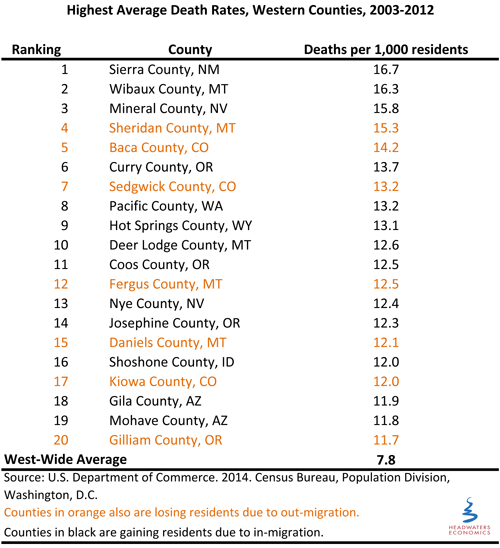Headwaters Economics is researching how western communities grow or shrink: through births, deaths, in-migration, and out-migration. While our report is not yet completed, in light of the upcoming All Hallows’ Eve it’s time to take break from our regular research and look at where the dead most recently were living.
But having a higher than average death rate does not mean a county is faring poorly. Like most things, it’s complicated. Basic demography tells us that high death rates will lead to a shrinking population unless those deaths are offset by births and/or in-migration.
Of these top 20 counties with high death rates, seven are also losing residents due to out-migration (highlighted in orange in the table). In these “orange” counties, those under age 65—the current and future workforce—are leaving. This does not make for optimistic long-run prospects either for the population or economy.
The remaining 13 counties in our list are gaining population through births and in-migration. In many of these counties, the new residents offset the relatively high death rate, leading to long-term population gain. Most are seeing a large influx of retirees, but they are also experiencing growth in the number of working-age people. This pattern is typical of retirement destinations, where older in-migrants can spur overall population and economic growth.
It’s important to note that only one of these 13 counties – Gila County, Arizona – has a birth rate that is high enough alone to offset deaths. This county is unique among our top 20 as a large portion of the county contains two Indian Reservations (Fort Apache and San Carlos), which tend to have a high proportion of young people and a high birth rate. It also contains the retirement community of Payson, which attracts older in-migrants, explaining the high death rate and high in-migration.
In the coming months, we’ll release a full report on migration in the West, reviewing what types of counties are growing, why, and what it means for businesses and residents.
In the meantime, on Halloween, we can say that the Grim Reaper is not necessarily a bad omen for a county’s long-term future.
Data Sources:
Nelson, P., A.W. Lee, and L. Nelson. 2009. Linking Baby Boomer and Hispanic Migration Streams into Rural America–A Multi-scaled Approach. Population, Space and Place 15: 277–293. DOI: 10.1002/psp.520.
Plane, D.A. 1999. Geographical Pattern Analysis of Income Migration in the United States. International Journal of Population Geography 5: 195-212.
Shumway, J.M. and S.M. Otterstrom. 2001. Spatial Patterns of Migration and Income Change in the Mountain West: The Dominance of Service-Based, Amenity-Rich Counties. The Professional Geographer, 53(4): 492-502.

